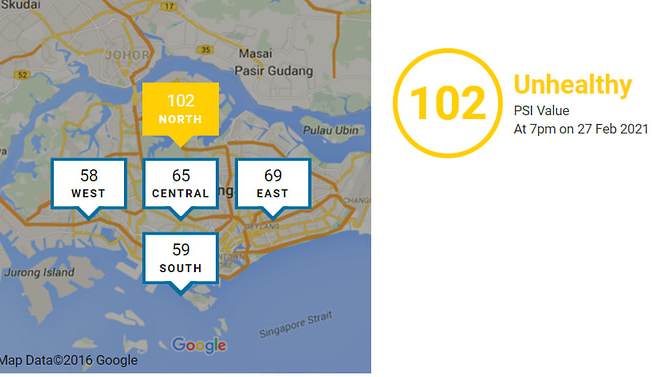Singapore typically has three seasons – Sunny, rainy and hazy.
We’ve recently left the cold rainy months, but before people living in the north can fully appreciate the warmer weather, something happened.
On 23 Feb 2021, Indonesian President Joko Widodo warns about the possibility of forest fires after hotspots were detected in Sumatra.
Shortly after, netizens in Singapore also reported that they’ve seen a bit of smokiness in the country.
have actually noticed a bit of haze here in Singapore over the last few days
— Andrew Janes (@AndrewJanes4) February 23, 2021
Well, turns out, it’s not them seeing things.
On 27 Mar 2021, at around 7pm, NEA reported that the air quality in the northern part of Singapore entered the unhealthy range.

It persisted for a few hours before dropping to 90 at 10pm.

Now, for those who are wondering if this incident is caused by forest fires (aka the start of the hazy season), it’s not.
NEA Confirms That Sudden High PSI on 27 Feb Evening Wasn’t Due to Forest Fires
According to the NEA, the air quality in Singapore is calculated based on six factors:
- PM2.5
- PM10
- ozone
- sulphur dioxide
- nitrogen dioxide
- carbon monoxide
Between 7pm and 9pm on 27 Feb 2021, the ozone sub-index was in the unhealthy range.
The PM2.5 readings were moderate, while the PM10 readings were in the good range.
Heightened Levels of Ozone
NEA went on to elaborate that the pollutants which caused the formation of ozone, such as nitrogen dioxide and volatile organic compounds were within the normal range.
So what could’ve caused a spike in the ozone sub-index?
According to the environment agency, weather conditions can play a part in the formation of ozone too.
“However, weather conditions such as ambient temperature, UV levels, wind speed, wind direction and rainfall can also influence the formation of ground-level ozone.”
On the day itself, the “maximum ambient temperature” was 35.3 degrees Celsius, the highest ever for the northern region of Singapore in 2021.
Combine that with “high UV levels” and it could’ve contributed to the unhealthy ozone levels.
So go ahead and heave a sigh of relief because at least we don’t have to deal with haze on top of COVID-19 right now.
Not that it matters, since we still have to wear masks anyway.
Here’s what you need to know about the hotspots in Sumatra, and why it’s causing alarm in the Indonesia government.
On a separate note, did you know that you can collect a mask for free in Singapore starting today? Click here to find out more.
Feature Image: Tang Yan Song / Shutterstock.com (Image for illustration purpose only)
Would you be jailed for being half-naked in public? Well, the answer will shock you. Seriously. Watch this to the end and you'll understand:




